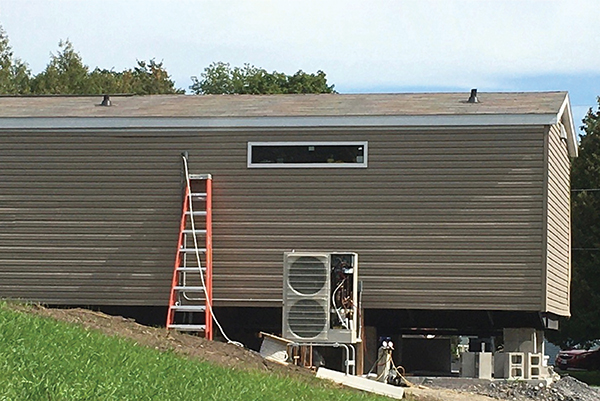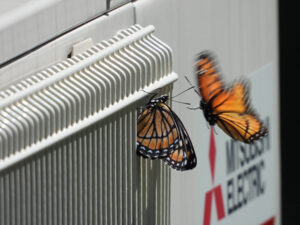
Living With a Cold Climate Heat Pump
November 29, 2023 | By Ian McTeer
Despite challenges that may occur with future electrical demand, today’s heat pump technology proves that it's up to the task for Ian McTeer, a Canadian homeowner.

In a world where conversations once revolved around weather complaints and TV show character analyses, it now seems that the hottest topic (pun intended) on the block is none other than heat pumps.
Move over cat memes and conspiracy theories; the new kid on the block is a sleek, energy efficient, super quiet heating and cooling appliance that’s rapidly gaining celebrity status.
Thanks to aggressive marketing, extensive media coverage, government and utility incentive programs—including favourable impressions imparted during water cooler chats and dinner parties—many people are impressed by heat pumps.
Heat pumps have become a world-wide phenomenon. The European Heat Pump Association (EHPA) reported unit sales increased by 34% to 2.18 million units in 2022. EHPA estimates EU households have installed 16.98 million units, approximately 14% of the heating market.
In North America, governments at all levels are promoting and even subsidizing heat pump installations and energy efficient upgrades with programs like the Canada Greener Homes Initiative.
The City of Toronto has prepared a number of impressive heat pump case studies including several hybrid systems working along with forced warm air gas furnaces. The studies were prepared by The Sustainable Technologies Evaluation Program (STEP) of the Toronto and Region Conservation Authority (TRCA). The case studies are linked through the City of Toronto’s website.
Another metropolis, the City of New York and its Housing Authority, has undertaken a truly innovative approach to public housing energy retrofits that could have much wider applications in cities across North America.
The Housing Authority has partnered with a heat pump appliance manufacturer to develop and test a cold climate heat pump window unit.
Initially, 60 heat pump window units will be installed in select public housing units. If proven to be successful, the New York Housing Authority will go ahead with a program to equip more than 30,000 public housing units with the new heat pump technology. I’m sure the tenants will be thrilled to have cooling available during the sweltering summers of New York City.
What Could Go Wrong?
“Everything should be made as simple as possible, but no simpler,” is a remark attributed to Albert Einstein. And it seems electrification of everything fits that philosophy, because as simple as it sounds to string a bunch of wires around town to power electric heating systems and to charge electric cars, it’s just not that simple.
The Canadian Federal Government wants Canada’s electrical grid to get to net-zero by 2035. Government modelling predicts an expenditure of more than $400 billion will be required to replace aging facilities, expand solar and wind power generation and to construct more interprovincial power transmission lines.
A huge battery storage capacity will be needed to help the system to adjust to peaks in demand from electric heating systems and electric vehicle changing stations.
The International Energy Agency said in 2022 that Canada would have to triple its electrical grid capacity by 2050 to reach the net-zero goal, yet analysts think doubling or tripling needed capacity by 2035 is doable; provided we get started right away!
Mario Chiarelli, a Toronto-based energy efficiency consultant told CBC News recently that converting Toronto’s 650,000 natural gas heated homes to top drawer inverter heat pumps would still have the effect of doubling the city’s electrical demand, increasing the load by an additional 5,000 megawatts.
No mention of the estimated electrical demand produced by the electrical conversion of residential apartment buildings along with institutional and commercial applications, many utilizing gas-fired boilers.
While the analysts hold that grid improvements, energy saving retrofits and battery storage technologies will help to reduce costs, it’s inevitable the price of electricity will rise in the short term.
Some idealists are convinced that energy costs could decline by as much as 12% by 2050 once the energy efficiency improvements have been made and reliance on volatile fossil fuel pricing has been circumvented by achieving the net zero goal.
It seems like such a monumental task, and it’s hard for me to be anything other than skeptical about massive changes to the electrical infrastructure in such a short period of time.
I’m the only one on my street with 100% electric heat. Everyone else uses natural gas. On a cold winter day (operating below my -8F/-22C balance point) with resistance heat and the outdoor unit operating together, my system requires approximately 45 amps in total.
My neighbour’s gas furnace draws approximately 6.5 amps to run the draft inducer, fan motor and low voltage circuits. Thus, [(45 – 6.5)/6.5] x 100 = 592.31% increase in amperage over my neighbour.
There are 20 houses on my street. Admittedly, I haven’t consulted with a hydro engineer about my local electrical infrastructure, but it makes sense to me that the above ground power lines on my street would not happily pass 592% more current without a major upgrade in wire and transformer size.
Electrification is a worthy goal, however, re-upping the grid so that every building gets the electrical service it needs may take decades longer than planned.
One Step Forward, Two Steps Back
In the U.K, where gas boilers once efficiently heated the average British home, air-to-water heat pump systems are being installed in ever increasing numbers. But not all is well, and Britain faces many of the same equipment related problems common to our own HVAC industry.
Too often units are improperly specified, existing systems are not properly evaluated for pipe sizing and flow rates, and accessories like large buffer tanks are installed in attic spaces with pipes running here and there.
The lack of qualified labour, seemingly a universal problem, means too many systems simply don’t work as designed.
The Daily Telegraph reported recently that the Scottish Parliament is debating a law that would prevent homeowners from selling their properties unless they changeout an existing gas boiler for a heat pump. This unpopular idea could cost each homeowner upwards of £10,000 (CDN$17,000). More recently they are proposing that new home buyers would have to replace gas boilers with heat pumps within two years of purchase.
Comments and photos from across the heat pump world too often point to heat pumps failing to live up to advertised efficiency.
United States Senator, William Brownsberger, posted “mixed results” with his heat pump earlier this year on his website. He reported the system suffered a leak, but even after repairs were completed, he claimed the heat pump was so inefficient “that the environment would have benefited more if his family hadn’t installed it at all.”
I have read other comments like this, but typically no system details are ever reported.
We will never know if the unit was properly specified, installed into an appropriate duct system, commissioned correctly and well maintained. The refrigerant leak was truly unfortunate, but it might point to the quality of workmanship rather than the unit itself.
When I see photos of outdoor units buried in snow, it seems to me the installers are not serious about heat pump performance (see Figure 1).

A snow-covered heat pump shows a lack of installation foresight. (credit: DARRYL PARKS/LINKEDIN)
My ccASHP Experience to Date
Since my Mitsubishi cold climate air-source heat pump unit was installed in September 2021 (read about it in HPAC, Dec. 2021), I can report excellent performance in both heating and cooling modes.
However, I’ve experienced several hiccups that cannot necessarily be blamed on the equipment.
I had one no heat situation in March of this year (2023). A horrendous ice storm knocked out power in our area for 75 hours. My all-electric system remained dormant throughout, and it was cold.
I now have a gas fireplace for backup. And on January 22, 2022, I ran out of heat as the outdoor temperature had dropped to -34C. My outside design temperature is -25C, and my system has previously maintained our preferred room temperature of 21.5C down to -30C without difficulty.
The extremely low temperature lasted only a few hours and the room temperature was maintained at 17C, so no real complaint (see Figure 2 below).

Figure 2. Our indoor temperature dropped temporarily during a rare overnight low of -34C.
Controlling the system became an issue. I had requested a thermostat with an internet connection. At this time, Mitsubishi does not provide an internet-enabled digital controller for this system, so I opted for a 24-volt Ecobee thermostat to control my equipment using an interface.
However, there were communication problems in the heating mode that created a few no heat and even a couple of ‘too much heat’ events. Sometimes the system did not start in the heating mode even though the thermostat was clearly calling for heat; several other times the system continued heating beyond setpoint.
I’m now using a Mitsubishi digital controller that works well, but I have no internet access to my system. I understand Mitsubishi will eventually have the type of controller I’m looking for, and I have nothing bad to say about the Ecobee thermostat, it’s a great product.
Foundation Failure
Perhaps the worst catastrophe to befall my system occurred in the spring of 2022. After several days of heavy rain combined with melting snow run-off from my septic drainage field and the roof of my modular unit (it took over a year to get my eavestrough installed!), a small river formed in front of my outdoor unit’s concrete pad and washed away a considerable amount of the gravel base, enough to undermine the pad so that it sunk down about an inch along the front side.
The outdoor unit tipped noticeably forward, fortunately there was not enough stress on the line set to cause a refrigerant leak.
After half a load of 5/8-in. base gravel and an afternoon’s worth of plate tamping, I managed to restore the integrity of the ground around the pad.
I did not risk raising the pad, I simply lifted the unit an inch and adjusted the legs so the unit is now level once again.
With the eavestrough now installed and a line of cedar trees planted in front of the unit to break the wind a bit and to prevent excessive drainage into the area around the heat pump, I’m confident that my unit will continue to perform as expected (Figure 3).

Figure 3. Unit secured safe and sound off the ground.
Positive Review
I would, wherever possible, recommend a cold climate air source heat pump like mine to anyone wanting to upgrade an older central HVAC system to benefit from improved efficiency, quiet operation and top-drawer heating and cooling performance.

The system has even been embraced by local Monarch butterflies who I witnessed flitting about my outdoor unit.
I’ve found it’s best not to consult social media for hysterical stories about heat pump failures, as too often those negative postings neglect to supply any crucial information about what we know goes into designing and installing a first-class heat pump system.
Based on my experience, I firmly believe there are plenty of hybrid and cold climate systems performing as advertised in Canada today.
More to be Done
I admire the efforts of industry groups and governmental agencies such as the aforementioned City of Toronto’s Sustainable Technologies Evaluation Program (STEP) for leading the way in demonstrating how to evaluate the heating needs of a building, then to go about specifying suitable heat pump equipment carefully installed by experts.
Heating systems of all varieties are expensive, and governments tend to throw cash at programs that may or may not be environmentally beneficial.
Wouldn’t it be better to subsidize high school and community college shop classes, along with those studying the principles of building knowledge techniques such as improved insulation and ventilation, rather than pay for second-rate heat pump installations?
Wouldn’t it be better to have one heat pump system working properly than to have two subsidized systems working poorly or not working at all?
While an emissions-free environment is a worthy goal, electrification of everything cannot occur without dramatic improvements to the electrical grid combined with an enormous expansion of our skilled labour force, and that, in my opinion, will take decades. <>

 Ian McTeer is an HVAC consultant with over 35 years of experience in the industry. He was most recently a field rep for Trane Canada DSO. McTeer is a refrigeration mechanic and Class 1 Gas technician. To start a conversation, Ian can be reached at imcteer@outlook.com.
Ian McTeer is an HVAC consultant with over 35 years of experience in the industry. He was most recently a field rep for Trane Canada DSO. McTeer is a refrigeration mechanic and Class 1 Gas technician. To start a conversation, Ian can be reached at imcteer@outlook.com.


